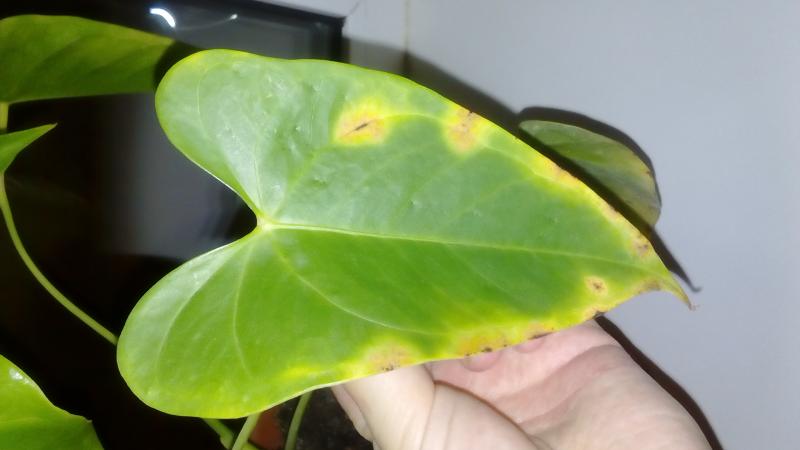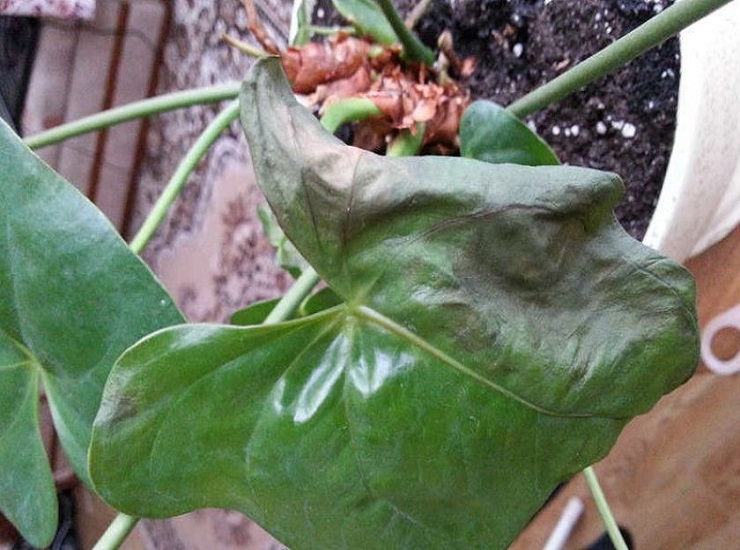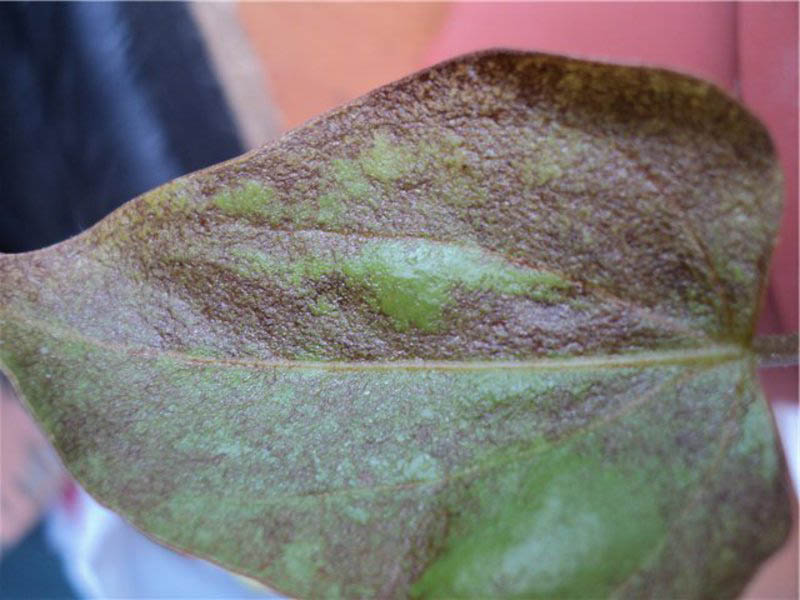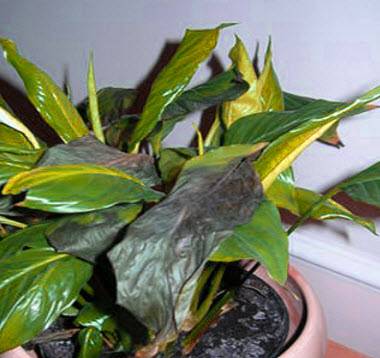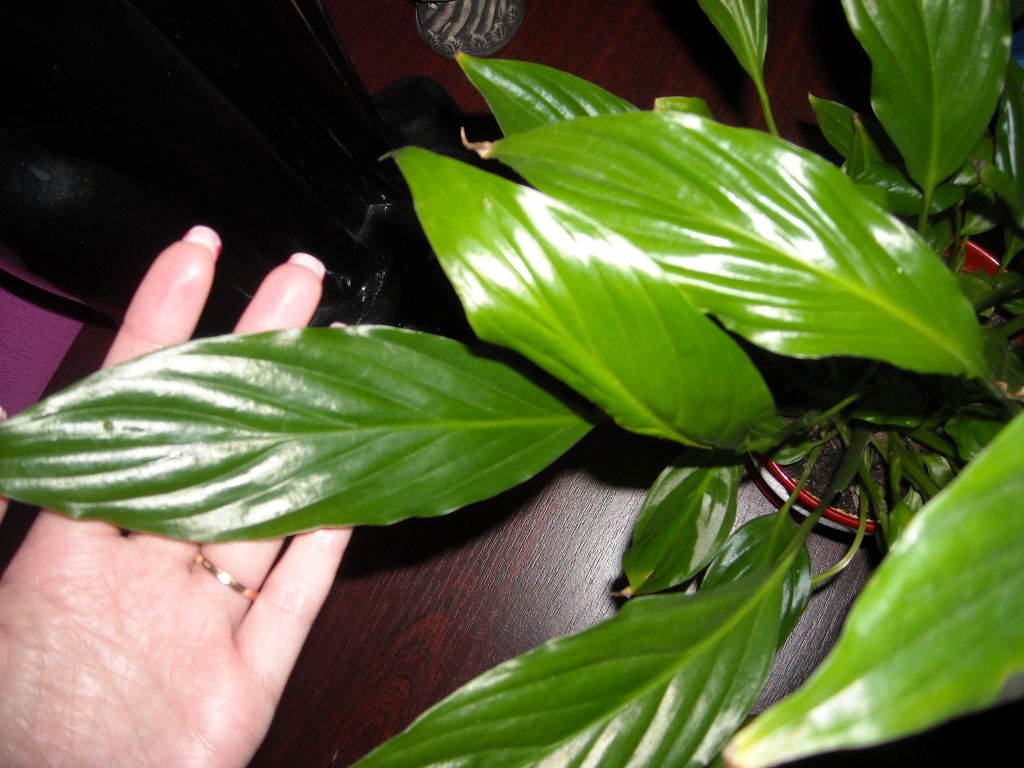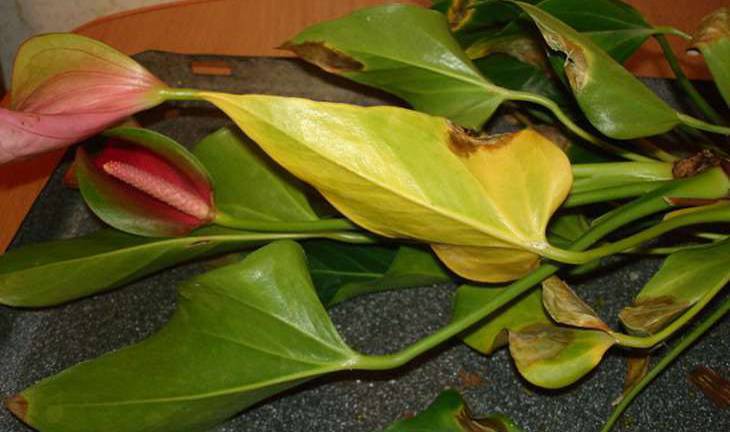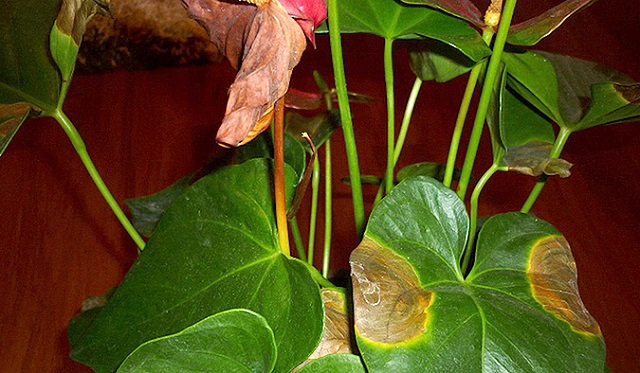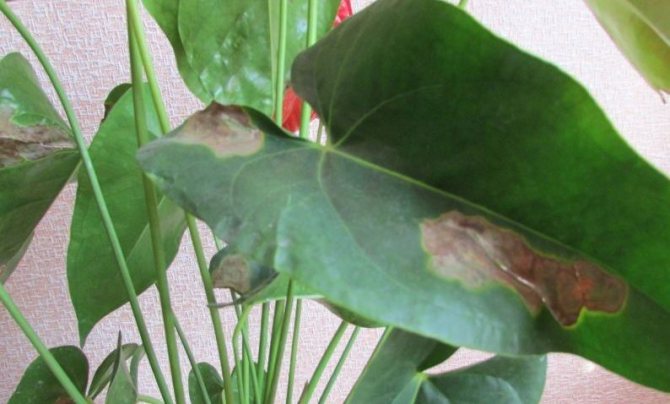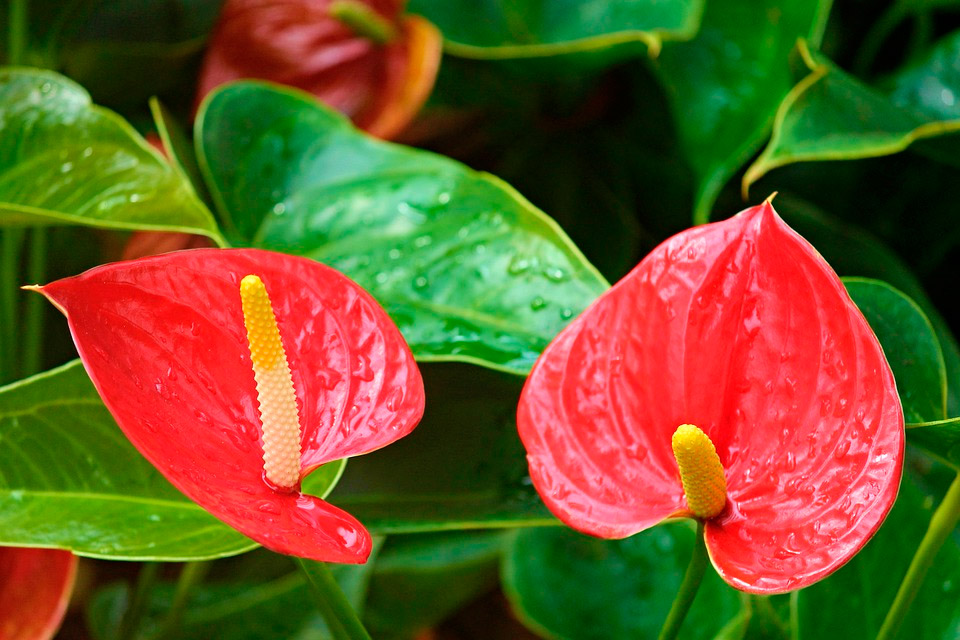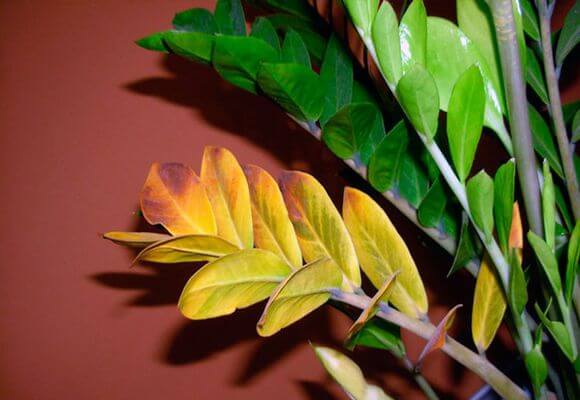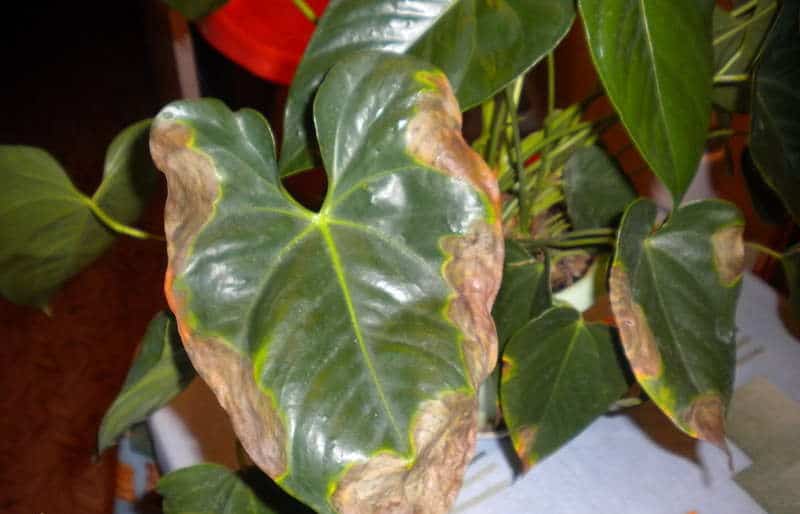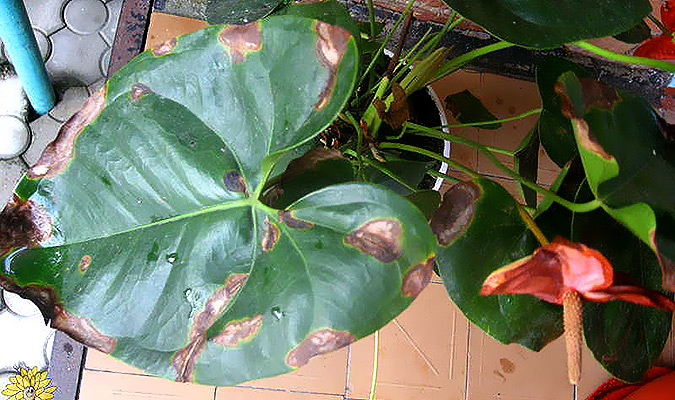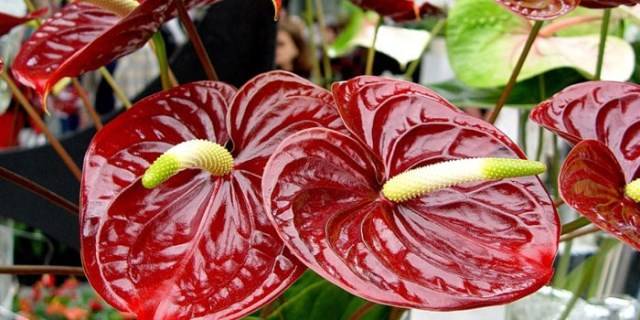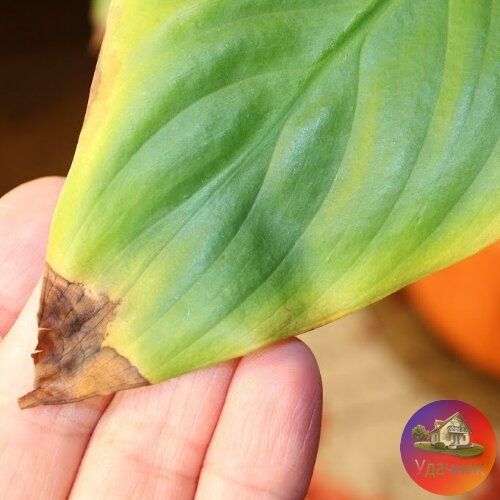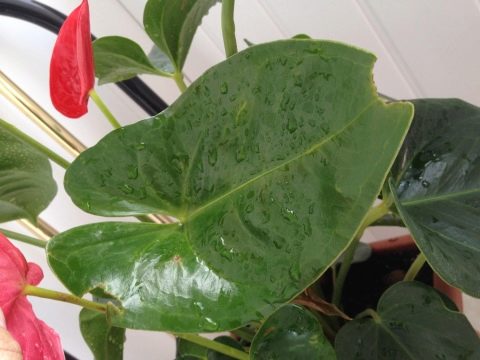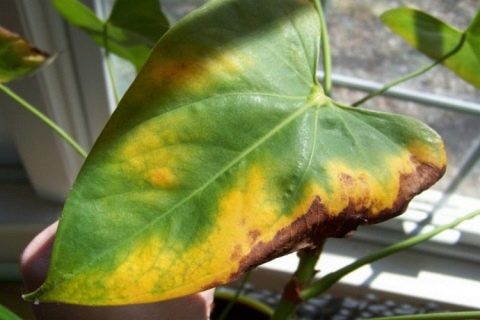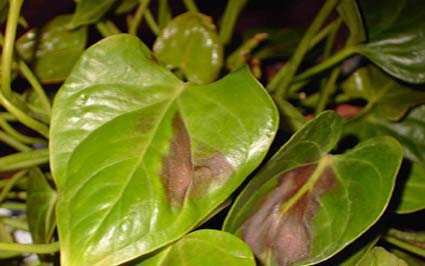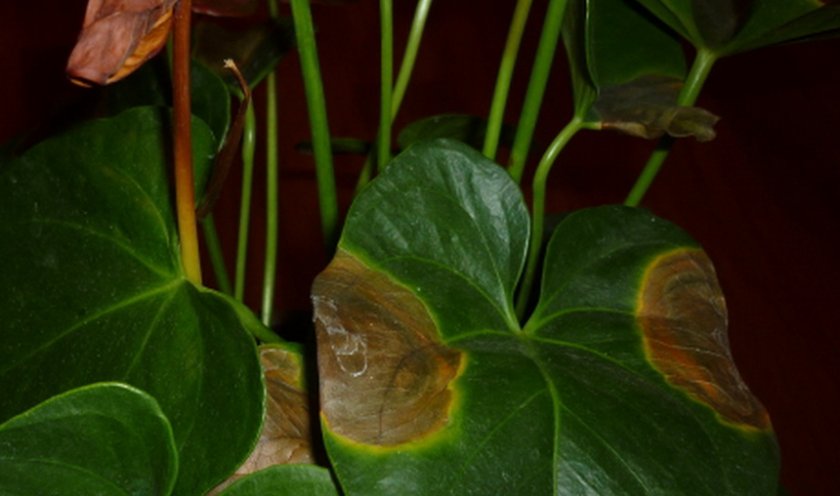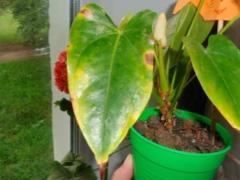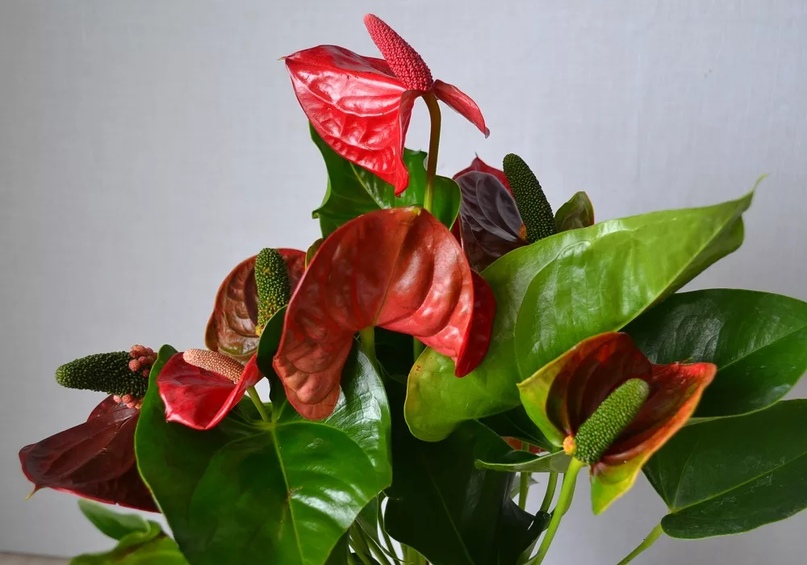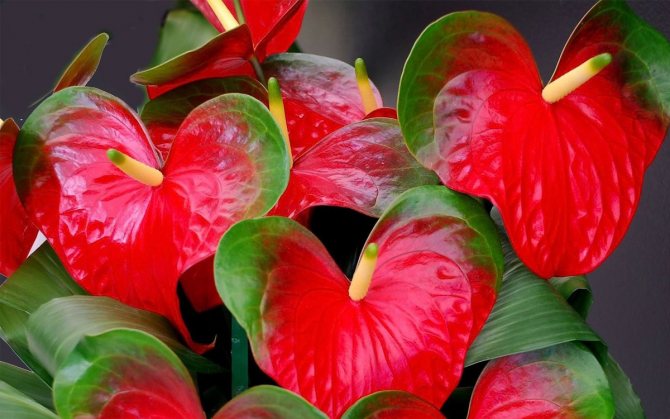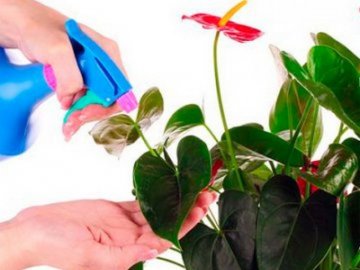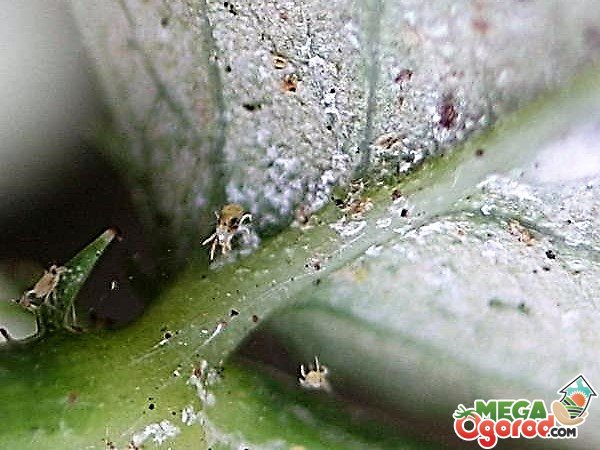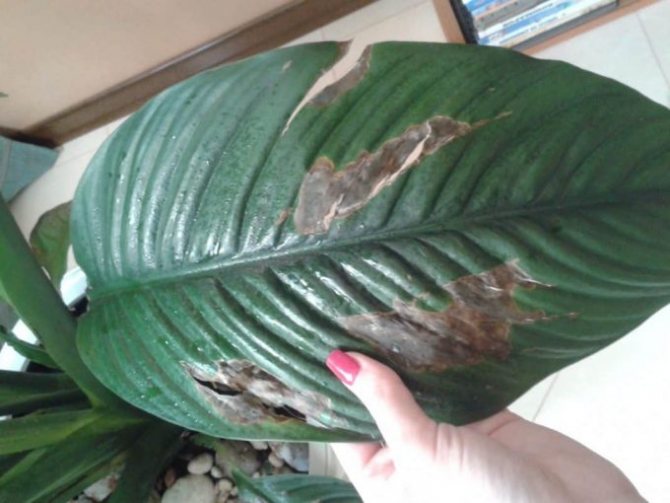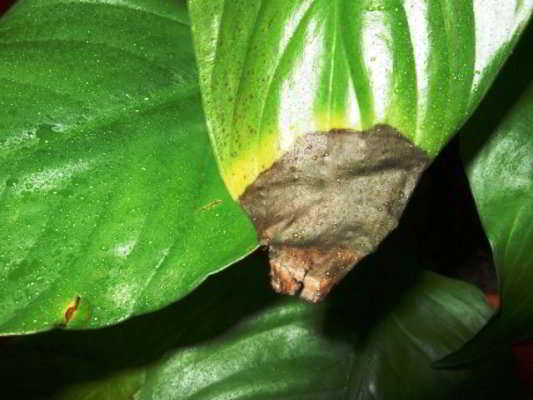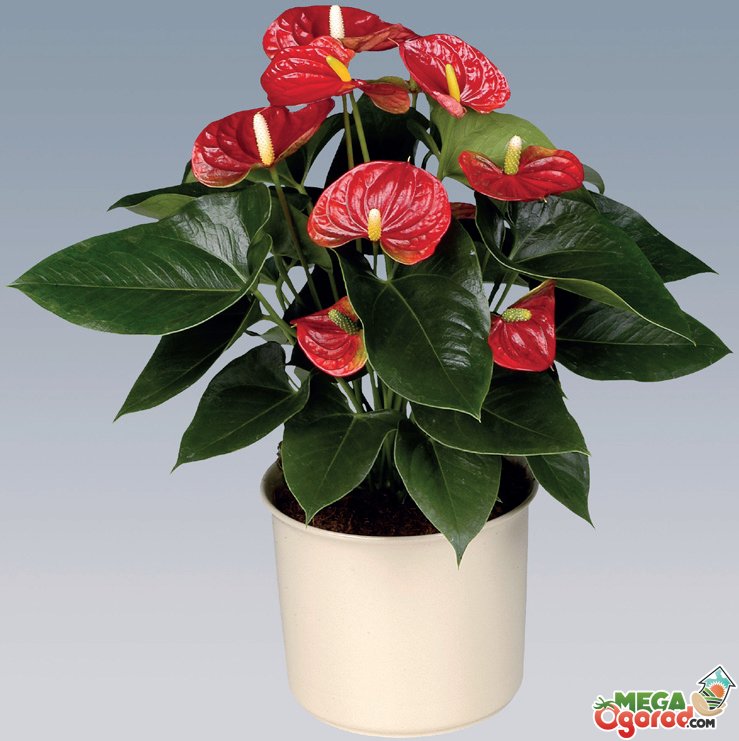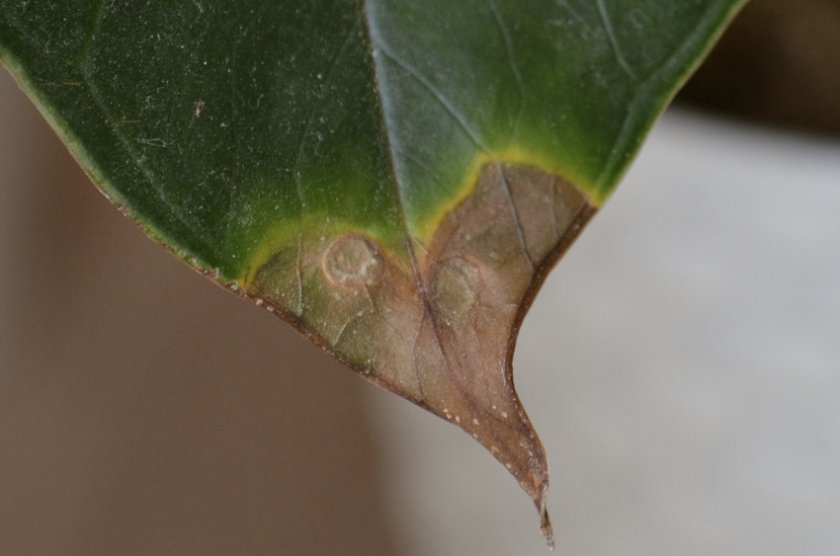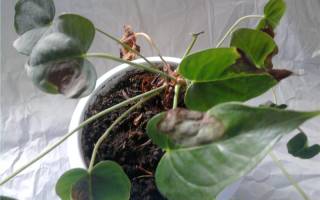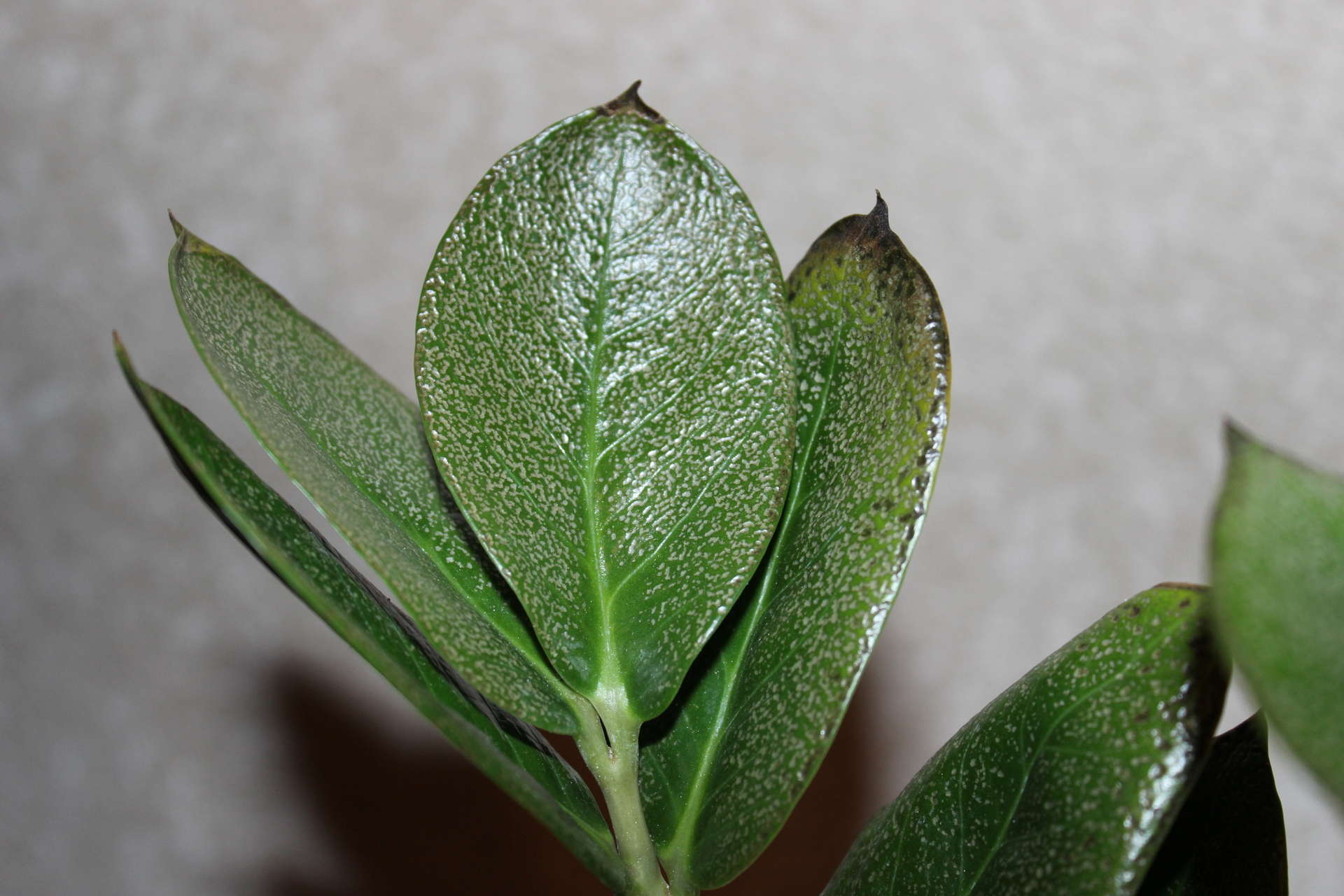Causes of the appearance of yellow and brown spots on foliage
If the leaves turn brown, then the reasons are:
- draft;
- low air temperature;
- soil quality;
- insects;
- lack of nutrients;
- direct sunlight.
Improper care and growth conditions
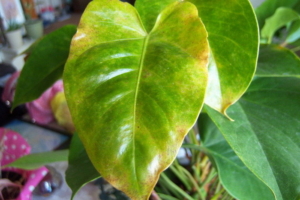
Damage to the leaves appears for the following reasons
- non-observance of a favorable temperature - dots are formed that develop into brown spots;
- being in direct sunlight - leaves get burned;
- insufficient watering, dry air;
- excess moisture, stagnation of water in the pot cause root rot and disease;
- lack of minerals causes yellowing of leaves, curling, and the appearance of spots.
Creation of comfortable growth conditions eliminates unfavorable factors. A flower purchased in a store is immediately transplanted by the transshipment method. Roots cramped in a small pot.
Reference! Leaves turn brown most often from low temperatures and excess water.
Temperature
A heat-loving tropical plant does not like coolness and direct sunlight. The room temperature is favorable for growth - from 180C to 280C. At temperatures below, spots appear, Male happiness dies.
Do not allow the plant to be found in a room with a temperature below +160.
Priming
Soil temperature is important. It should not be lower than the air temperature
The plant requires special soil. Purchase is possible in a flower shop or online. It is not difficult to prepare the soil yourself. Includes:
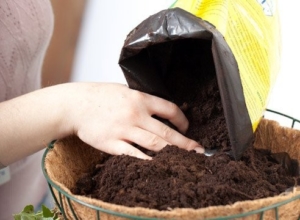
- chopped moss;
- peat;
- sod land.
The parts are connected in equal parts. Expanded clay or drainage is poured at the bottom of the dishes. The soil is made breathable, lightweight, moisturized.
Water stagnation should not form in it. The water is poured from the pallet after watering. Roots rot quickly in wet soil.
The soil is acidified once a month. Citric acid is added to the water for irrigation at the tip of a knife.
If limescale forms in the soil after hard water, then the harmful salts are removed from the small pot. For this:
- pour the liquid onto the soil surface to the edge of the pot;
- through the drainage hole, water is poured out together with calcium salts.
Lighting
- Male happiness prefers bright diffused light. Direct sunlight causes burns.
- Damage appears as small brown spots after watering. The water droplets become lenses that collect rays on the surface of the leaves, which burn the greenery.
- In the shade, the flower does not bloom, the stem lengthens, the leaves are crushed, turn pale. The appearance of anthurium deteriorates from insufficient lighting.
Watering

Water should be regularly and moderately filtered, settled liquid. Tap water is not good. Cold water damages the roots.
Hard water in the soil accumulates calcium salts. Lime deposits settle on the walls of the pot and on the surface of the soil. Excess calcium on plant foliage forms brown spots. To maintain normal humidity:
- the flower is watered during active growth every 3 days;
- in winter, watering is reduced to 1 time per week;
- sprinkle or wipe the foliage daily.
The beginning of the heating season in the room causes a drop in humidity. This disadvantage is eliminated by regularly spraying soft water from a spray bottle. The temperature of the liquid is made one to two degrees higher than the temperature of the room.
Important! The plant is watered with soft water, the liquid is not allowed to stagnate in the pan.Over-watering is the most common cause of flower death.
Wind
You can not leave the plant in a draft, allow a gust of wind to enter. Even an open window harms the anthurium. Try to carefully choose the location for it.
Pests
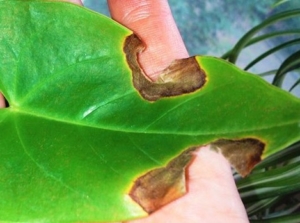
- the plant is examined, isolated from other indoor flowers;
- a cotton swab is moistened in an insecticide solution, insects are removed;
- the leaves are washed with soapy water and kerosene.
The procedure is carried out until the bugs are completely destroyed.
To remove insects, the plant and soil are treated:
- a mixture of water with grated garlic and laundry soap;
- a pale pink solution of potassium permanganate.
A healthy plant has strong leaves. With proper care, one or more leaves turn yellow. They are cut off. This is the natural aging of the plant. The cut is treated with charcoal. New young leaves grow in this place.
Why do leaf tips dry
If the deciduous edge dries up and becomes thinner at the edges, it is most likely anthracnose, also a fungus that needs to be treated with appropriate drugs. When the tips of the leaves dry and then curl up, this is a greenhouse aphid, which can only be dealt with by using insecticides - Actellik or the well-known Karbofos.
In the absence of diseases, if only dry foliage is observed, the container with a flower is removed to a safe distance from the heating. Daily spraying should be included in the flower's diet - regardless of the season.
If the matter, after all, is in anthracnose, anthurium is urgently transplanted into new soil, to which charcoal, pieces of red brick and small parts of forest cones are added. The addition of large particles of natural substances will help to make the soil loose, as a result of which the flow of oxygen to the roots will increase.
Signs of dry and wet blackening of spathiphyllum leaves
Darkening of foliage is the process of the appearance of black or brown spots on its surface. Subsequently, they deform and dry out. Initially, the leaf plate may turn yellow. Then it acquires a dark shade, blackens, dies off.

Spathiphyllum is a beautiful ornamental plant
The leaf can be covered with dark spots evenly or randomly. If you do not take action in time and start treating the bush, the leaves completely turn black and die off. Moreover, at the very beginning of this process, all the decorativeness of "female happiness" is lost.
If the leaves of the spathiphyllum turn black, this indicates a violation of the rules for caring for the crop. Outwardly, this symptom may look different:
- The ends of the leaves of the spathiphyllum dry and darken. This creates a large brown area around the edges. After some time, these fragments dry out and become more fragile. Affected leaves die off and crumble. If they do not fall off, the bush still becomes less decorative. In this case, we are talking about dry blackness.
- There is also a sluggish or weeping darkening. At the same time, black leaves acquire a moist consistency and become softer and slippery. They are losing their density. This phenomenon often becomes very widespread and widespread. Spores, mold, fungi are often formed on the affected area.
It should be borne in mind that the ends of the leaves or the entire plate may darken in the plant. Also, the roots and flowers of the plant sometimes acquire black color. Depending on the provoking factor, the affected fragments grow rapidly.

With improper care, the leaves of spathiphyllum turn black
The main diseases, their causes and methods of control
Plant problems become noticeable by discoloration, deformation of leaf plates and petioles. The appearance of spots, plaque, drying out, wilting, loss of gloss in the aerial part is possible. Diseases of a culture are diverse and arise for various reasons.In most cases, a violation of the indoor flower maintenance regime becomes a provoking factor.
Having noticed the first signs of ill health, you should immediately take measures so as not to lose the plant. The defeat of the root system can begin much earlier than more noticeable symptoms appear.
Anthurium diseases occur for several reasons:
- violation of cultivation agrotechnology;
- fungal, bacterial infections;
- settlement of pests.
Non-infectious
This group of diseases is provoked by improper living conditions or inadequate care. Anthurium prefers to grow in an environment of high humidity, heat, sufficient, but diffused lighting. Excess water entering the rhizome often causes decay.
Diseases in which the leaves of anthurium dry out due to insufficient watering or low ambient temperatures:
- Chlorosis manifests itself when hard chlorinated water is used when the soil and aboveground parts are moistened, the feeding regime is violated, and when drafts are exposed. Characteristic symptoms arise from the lack of a drainage layer in the flower pot, leaving the liquid released after watering in the pan.
- Exposure to direct sunlight causes burns to the leaf plates of the anthurium. Almost all members of the species require good and long-term illumination, but cannot tolerate the sun. The resulting dry spots will not heal.
- Hypothermia, high humidity, low temperature provoke the development of plant pox.
- Sharp changes in thermometer readings, drafts, excess moisture in the air, followed by drought, lead to enation. This disease causes curvature, deformities, hump on the leaves, their uneven growth.
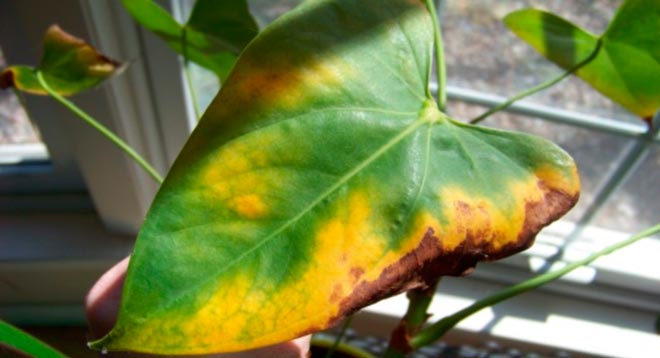
Non-infectious lesions can be cured by creating optimal conditions for growing anthurium. In addition to the microclimate, timely, full-fledged care should be provided, which is required for a particular type of culture during a certain growing season. It is permissible to use various growth stimulants to accelerate the recovery of damaged tissues. Ignoring the symptoms will lead to the loss of decorativeness of the indoor flower, the appearance of diseases and pests due to reduced immunity.
Infectious
The provoking factor of most diseases is an unfavorable environment. Anthurium is often attacked by fungi, bacteria, viruses when kept in conditions of low or high temperatures, excessive moisture, lack of nutrition and light. Strongly weakens the houseplant effect of drafts.
The most common infectious diseases of the flower:
- gray mold;
- anthracnose;
- fusarium;
- septoria;
- root, stem rot;
- sooty mushrooms;
- rust;
- powdery mildew.
Anthracnose
The fungal disease is typical for crops grown in the open field, but when certain conditions are created at home, it also affects plants. A comfortable environment for anthracnose is a temperature of + 23 ... + 27 ° C and an air humidity close to 100%. With the disease, brown dry spots appear, covered with black dots. The affected leaf becomes colorless, wrinkles, falls off. In this case, infection of the root system of the anthurium is possible.
Aging leaves of anthurium
Like other plants, the leaves of anthuriums can turn yellow for a completely natural reason, due to old age. In such cases, the inevitable processes primarily affect the foliage located closer to the ground.
Yellowness, spreading from the edges of the leaf plate, gradually covers it completely, the leaf loses its elasticity and juiciness, and then turns brown. If it is not removed, such an anthurium leaf dries and falls off on its own. If the plant is kept in proper conditions, then the fall of old leaves does not damage the anthurium, because at the same time, new healthy foliage is actively appearing at the top of the stem.
Since the process is natural and inevitable, there is no need to worry about it. However, flower growers often have a question: "Is it necessary to remove yellowed or dry leaves of anthurium?"
Obviously, such leaf plates no longer perform their main function, but the plant spends certain forces on their maintenance. Therefore, it is better to cut off the leaves that have become obsolete, making life easier for the entire plant and making it more attractive.
To prevent the cut from becoming a place for the spread of infection, it is useful to treat the cutting tool, be it scissors or a knife, with alcohol, and sprinkle the damaged tissue on the anthurium with chopped charcoal.
If the leaf still retains its juiciness, you should not tear it off by hand, because this can seriously injure the stem.
In addition to natural reasons why anthurium leaves become stained or dry, flower growers have to deal with the consequences of mistakes they made when caring for a houseplant.
The next reason for yellowness is the size of the pot.
A large pot is the doom for the anthurium. Moisture will accumulate at the bottom of the pot, and thereby provoke root festering, which leads the anthurium to death. In order to save the plant, you must:
- Choose a medium-sized pot (not too small, but also small).
- To transplant a flower, you first need to cut off the decayed tips of the roots.
- Root cuts must be treated with charcoal powder from wood and allowed to dry.
- Cover the bottom of the pot with small stones or expanded clay
- Next, add fresh soil.
Anthurium loves warmth and good lighting. The light from the sun's rays also has a detrimental effect on the flower. He does not tolerate this, so the green leaves also turn yellow from ultraviolet radiation and spots appear on them. If the flower is on the windowsill, then it is impossible to avoid sunburn. Yellowed areas and leaf spots are burns. At best, diseased leaves dry and fall off, and at worst, the flower will wither.
How can you avoid this and save the plant, but still give the necessary light? It is necessary to find a place in the house with good lighting, where direct sunlight will be reduced to a minimum.
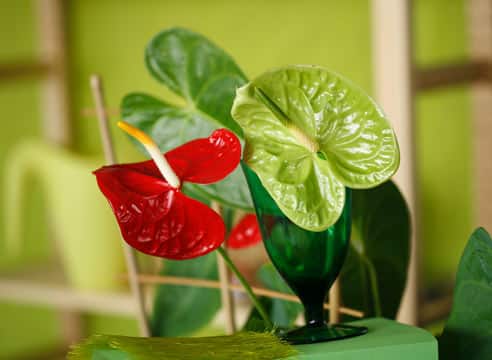 Growing a tropical flower
Growing a tropical flower
Temperature also has an effect on flowers. You cannot keep the plant indoors where the temperature can reach below +10 degrees. It is not recommended to leave anthurium in a draft or on a windowsill in the winter season, this will lead to frostbite.
Anthurium is resistant to temperature changes, but it is better to keep it in a warm place. Then the risk of yellow patches will decrease.
The above reasons are the consequences of improper care. In addition, there are anthurium diseases, which is why color changes and drying of leaves appear.
- Septoria (anthracnose) is a disease that is spread from plant to plant. At the same time, the leaves turn yellow and dry. It is quite difficult to save the plant in this case.
- Chlorosis is an infectious disease that occurs due to a lack of magnesium and iron. Yellowish, green (dark) or brown spots appear on the leaves, but the veins of the leaves remain green. To cure such an ailment, it is necessary to apply chilates, which contain both magnesium and iron.
- Gray rot appears in case of high humidity or frequent watering. Therefore, it is necessary to control the frequency and amount of watering. At the same time, brown shades and spots appear.
- Rust on the leaves manifests itself in mottling on the upper part of the leaf, and on the lower part, spots are formed containing powder with spores.
- Fusarium is a fungal disease that affects the leaves. They turn yellow, dry and wither, and eventually fall off altogether. The disease is transmitted from other plants or through the soil in which the flower grows.
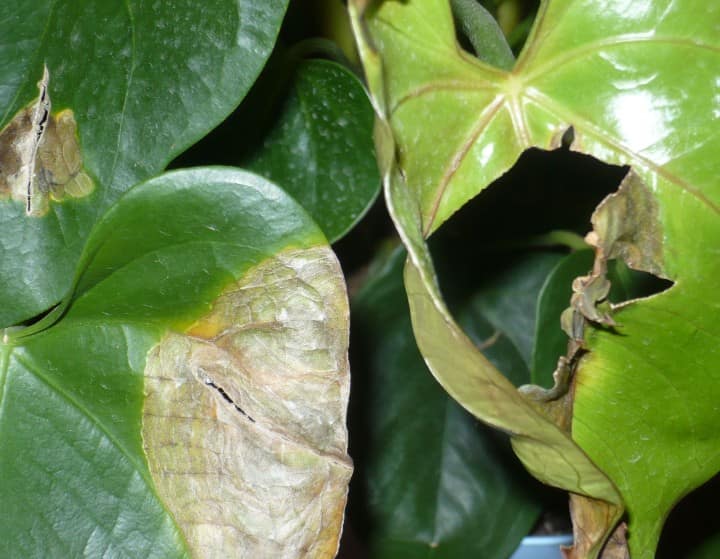 Fungal disease of the plant
Fungal disease of the plant
Causes of anthurium diseases, their treatment
Leaves turn yellow
If during the cultivation of anthurium leaves turn yellow what to do, many owners do not know, however, the reasons for the troubles are obvious: often the problem is caused by mistakes in care and uncomfortable conditions to which the flower quickly reacts with a protest.
Leaf damage is a sign of a sick flower
Conditions that determine why the tips of leaves and flowers dry in anthuriums:
- irrigation in direct sunlight;
- dim light in the room;
- deficiency of nitrogen bait;
- small flowerpot;
- watering with hard, too cold and not settled water.
Yellow or brown spots on the leaves of a plant often signal diseases that require surgical treatment. Waterlogging of the soil and low air temperature threaten with bacterial and fungal diseases of anthurium leaves:
- fusarium is introduced when the soil is changed;
- chlorosis manifests itself with a lack of iron and magnesium;
- septoria is a consequence of drafts, cold, humidity;
- rot is formed when the air humidity is high, the leaves can turn brown with excessive watering.
On a note! Do not forget about the natural feature of the old anthurium, when the leaves turn yellow for a natural reason. What to do? The right decision during the period of crop renewal will be to reduce watering and feeding.
Why do leaves and flowers turn black and dry
Blackened anthurium is provoked by the following factors:
Watering with cold water. The optimum temperature of the liquid used to moisten the culture is 22-26 degrees. The permissible deviation from room temperature is 2-3 degrees.
Rhizome decay. The solution to the problem of why the leaves of anthuriums turn black should be sought in improper watering. Excess moisture causes blackening and death of the plant.
Fungus on the roots of anthurium. With insufficient drainage, the flower begins to suffocate and dry out. To prevent the disease, you should loosen the ground and create additional holes in the pot.
Hard water. Excess calcium negatively affects magnesium and potassium levels. The percentage of capacity of iron, manganese, zinc, boron also decreases. The lack of useful elements makes the anthurium dry out.
Excess fertilizer. The dosage should be halved or the feeding should be stopped temporarily.
Moisture deficiency. Symptoms - the leaves began to curl and darken, a change in the usual shape
It is worth paying attention to spraying the crop or placing a pallet with water next to it, providing increased moisture to the plant.
Blackening of anthurium leaves
On a note! Pests are the most dangerous enemy for the anthurium flower. Why the leaves and flowers turn black and dry, the reason should be sought as a result of the vital activity of the whitefly and aphids. If the fears are confirmed, the affected areas are washed with soapy water, treated with pesticides.
Sticky leaves how to treat
Dense foliage protects "male happiness" from various parasites. But you shouldn't lose your vigilance
When sticky secretions appear on anthurium, brown spots on the leaves, it is important to know what to do in the fight against the scabbard. Usually the pest is removed with cotton swabs, the bush is treated with actaric solution - for 2.5 liters of water 2 g
In case of minor damage, it is enough to wipe the foliage with soapy water. Also, the flower is treated with "Karbofos" (2%).
Anthurium does not grow
If the anthurium does not grow what to do, the florist determines, based on the conditions of the culture, where the main factor is location in an open and well-lit place, without drafts. Often, amateurs make a mistake when planting a flower. The soil is not suitable for the plant, a transplant or drainage is required - additional reasons why anthurium does not grow.
Remember! The flower prefers plastic containers, deep-fiber substrate and does not tolerate exposure to direct sunlight. Pots for young individuals are changed once a year, for adults after 3-4 years.
We reanimate anthurium after mistakes in care
Many growers misunderstand the advice of maintaining high humidity for anthurium and begin to flood the plant. As a result of such care, root decay, which manifests itself in various spots on the leaves.
The yellowing and drying of the edges of all leaves is immediately caused by the excessive dryness of the air. Often appears on anthurium during the beginning of the heating season. It is treated by an increase in humidity: additional spraying or a pallet with wet expanded clay.
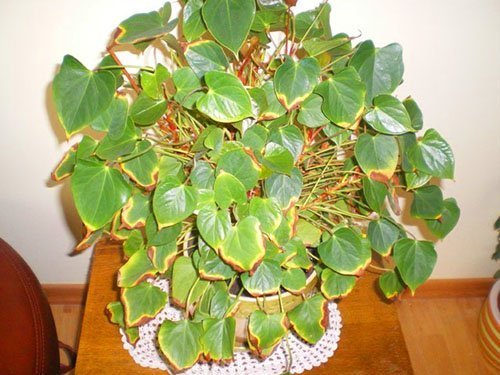
The yellowing and drying of the edges of the leaves is associated with dry indoor air.
Deformation of leaves and flowers occurs in very dry soil and air. The plant lacks moisture and therefore young leaves and flowers unfold gnarled and deformed. It is corrected by regulating irrigation.

Leaves and flowers open deformed in conditions of low humidity
Yellowing of the leaves. A symptom of several diseases at once.
- prolonged waterlogging of the roots, as a result of which part of the root system rotted and the leaves lack nutrients - requires an urgent plant transplant with the removal of rotten parts of the roots and planting in fresh soil;
- watering with chlorinated water - if it is not possible to water with rain or melt water, then stand for ordinary water for several days in an open container;
- too large a dose of fertilizers - it is treated by pouring soft water and stopping feeding for 1 month;
- insufficient nutrition - apply mineral supplements for flowering plants;
-
insufficient lighting - mainly manifests itself in winter, the plant needs additional lighting with lamps.
Black tips of leaves. Excess calcium salts in tap water or hard water. Nothing can be done with crippled leaves, and young leaves will grow healthy after changing the water for irrigation to soft.
Various brown dry spots, holes in the leaves. This is a sign of a disease of the root system due to hypothermia, cold watering, improper soil. The plant should be rearranged to a warmer place, and the soil should be allowed to dry. Very often, owners of newly acquired anthuriums face such a problem during the cold season. Even a small dash to the car with this delicate plant can damage the leaves.
Revitalization of a plant affected by rot
In cold and wet soil, the roots of anthurium often rot, the leaves begin to wither, dry out, and fall. If the plant is neglected to such an extent that not a single living leaf remains, then the chances of resuscitation are very small.
- The remaining plant is pulled out of the ground and gently washed in warm water.
- By examining the remaining roots, you can understand the size of the disaster.
-
If there are growth points on the light roots, then there is a chance to revive the anthurium.
- The plant is dipped in a disinfectant solution (possibly in a light solution of potassium permanganate) for 15–20 minutes and then dried.
-
Transplanted into a root-sized pot with soil for anthuriums.
- They are placed in a warm place, watering is limited until new leaves appear, then watering is careful.
We save the anthurium that has lost its roots
Various rot and infections often begin with root rot. And sometimes there is nothing to save there, but if the leaves and trunk of the plant are alive and without signs of mass disease, then you can try to root the upper part of the anthurium with air roots.
- Cut the plant to living tissue, anoint the cut with greenery, dry for one or two hours.
- Plant the top in anthurium soil.
- Cover the aerial roots with moist sphagnum moss.
-
The plant will reach the ground with aerial roots and the plant will grow again.
We save the frozen flower
If the leaves of the anthurium are slightly frozen, then a healthy plant will be able to recover. It is much worse if, shortly before this, the anthurium was watered and the roots were exposed to hypothermia. All damaged leaves should be cut off, the plant should be transferred to a warm room and sprayed with a solution of the HB-101 vitalizer.If in the following days the plant becomes worse, it means that the roots are damaged, and the plant should be immediately transplanted, cutting off all the rotten areas, and cinnamon should be treated with the cuts. Stimulant HB - 101 can be sprayed and watered to strengthen the immune system.
Video - disease prevention
An important prevention of anthurium diseases is regular inspections of the plant, which are carried out when wiping the leaves. Then you will definitely not miss the warning signs of the onset of the disease and will be able to heal the plant in time.
And in order for it not to hurt, observe the conditions of detention.
What to do to save a flower
It is worth starting to save the plant with proper care for it, and then carry out those procedures that correspond to the type of disease.
With a fungal disease or infection with bacteria or viruses, spontaneous salvation is unlikely. Therefore, first of all, they get rid of all the leaf plates that are burned so that the infection does not spread to other domestic flowers.
The appearance of a gray bloom on flowers, leaves, as well as reddening of the lines and tips indicates a gray mold disease. Young and newly transplanted anthuriums are more often infected. This is mainly a consequence of abundant watering, poor-quality drainage, ignoring the removal of dry and dead parts of the plant, neglecting airing the room.
With the development of septoria, it is necessary to spray the leaves with a chemical fungicide, which contains a large amount of copper. If rust develops, it is worth spraying the shrub more often, increasing the humidity in the room, and the affected greens are cut and burned.
To cure anthracnose, you need to reduce watering and spray with copper fungicides from a spray bottle. You can also add the chemical abiga-peak to the soil substrate.
Note! If the flower does not respond to treatment, then it is burned so as not to infect the rest of the indoor plants in the house. To eliminate fusarium wilting, you will have to treat the plant with copper insecticides and spray the soil substrate with glyocladin
It is best to get rid of all the soil, before transplanting, place the plant for a short time in a weak solution of potassium permanganate and plant it in fresh soil. The soil is disinfected
To eliminate fusarium wilting, you will have to treat the plant with copper insecticides and spray the soil substrate with glyocladin. It is best to get rid of all the soil, before transplanting, place the plant for a short time in a weak solution of potassium permanganate and plant it in fresh soil. The soil is disinfected.

Shield
If a scabbard is found, it is necessary to immediately carry out mechanical cleaning and apply insecticidal preparations. When fighting thrips, these remedies are also used.
Finding a spider mite early on can give the flower a warm shower. If there are a lot of insects, then special preparations are used against this parasite. Treatment for this parasite will take a long time. The cobwebs must be removed, the pot and the window sill are wiped.
Important! The difficulty is that the remaining larvae live for a long time and can reappear even after a year. Therefore, it is necessary to carry out periodic treatment with soapy water of the affected plant and those specimens that are next to it.
3 Leaves on a flower turn yellow, wither, dry
The reasons why the appearance of the plant deteriorates are varied. They can be identified by the nature and rate of propagation of the defect. Anthurium can turn yellow and dry leaves for several reasons at once (insufficient or excessive watering, cold, drafts or low air humidity).
| External signs | Cause | Remedies |
| The leaves turn yellow evenly, the stems are pale and elongated, the plant grows poorly and does not bloom | Lack of lighting | Artificial supplementary lighting in such a way that daylight hours are at least 12 hours |
| Leaves turn yellow, anthurium does not bloom and grows slowly | General nutritional deficiencies | Complex regular feeding |
| Leaves grow deformed, irregular, dry out | Dry air and soil | Increasing the intensity of watering, humidifying the air |
| Leaves turn yellow, in whole or in irregular spots, while the veins remain green (chlorosis) | Lack of iron and magnesium in the soil | Top dressing with mineral complex fertilizers |
| Leaves turn yellow at the tips and at the edges, a dried edge appears | Low temperature, drafts | Moving the anthurium to a suitable place, additional protection from the cold with the help of a warming pots |
| The tips of the leaves turn yellow, then turn brown | Insufficient air humidity | Air humidification |
| The tips of the leaves turn black | Watering with hard water with an excess of calcium | Replacing the water source for irrigation or softening it |
| Stalk rots | Excessive deepening of the plant during the next transplant or excessive watering | Plant transplant, reduce watering |
In city apartments, tap water is too hard, this is not suitable for watering anthurium. You can determine the hardness of water using a special indicator (the indicator should be at a pH level of 5.5–6.5) or using household methods. Water is unacceptably hard, if after washing a cloudy coating remains on glassware and plumbing, lime deposits and flakes regularly accumulate in the kettle.
Uneven yellowing of anthurium leaves indicates a lack of mineral supplements.
Water is softened in several ways. The best option is to pass it through a special softener filter. But even without buying special equipment, the problem can be solved with improvised means:
- 1. Add a small amount of acid (citric, acetic) to tap water.
- 2. Freeze water in the refrigerator. The clear water bottle is placed in the freezer for several hours. You need to get it out when part of the water turns into ice. Unfrozen water is drained, it collects a large amount of salts, and thawed water is used for irrigation.
- 3. Set aside water in a large container, use only the top layer for irrigation. The method is suitable for moderately hard water.
- 4. Add chopped needles or bark of coniferous trees to the anthurium soil. This simultaneously acidifies the soil and makes it more permeable, which is very beneficial for the plant.
- 5. Water the anthurium with distilled, melt or rain water. In the latter case, disinfection is desirable, since when watering, spores of fungi-pests or bacteria can get into the soil.
Air humidity can be increased regular spraying of plants, wiping the leaves with a damp sponge. To maintain a humid environment, a humidifier, a decorative fountain or just an open container of water is placed on the windowsill next to the anthurium. The container with anthurium itself can be placed on a wide pallet filled with pebbles, decorative stones or moss. This design not only humidifies the air, but also decorates the windowsill.
But it is important to ensure that the water in the pan does not rise above the bottom of the pot with the plant - this will lead to waterlogging of the soil and rotting of the roots. It is especially important to humidify the air during the heating season, when the heat rising from the battery creates a dry microclimate.
Features of anthurium care
It is believed that anthurium has a rather capricious character and experienced flower growers do not recommend that beginners in this matter start their collection of domestic plants with this particular species.
Some varieties of anthurium can be grown exclusively in special greenhouse conditions. In addition, the sap of the plant can contain toxins and cause irritation of the human mucous membranes.
The plant does not tolerate bright light, so it is better to keep it in partial shade or use bright, but diffused light.In winter, anthurium needs an additional light source. If the lighting is insufficient, for example, a bush pot is located on the north window, the plant will not bloom.
The optimum summer temperature for a plant from the tropics is 20-25 degrees; in winter, the plant easily tolerates temperatures of 14-16 degrees.
Drafts should be avoided, they can provoke the death of anthurium.
Considering that the natural habitat of the plant is the tropics, where a humid climate prevails, it is important for anthurium to maintain high humidity in the room. The leaves of the plant need regular spraying, but the flowers do not tolerate the ingress of water on them.
From this, the inflorescences become stained and die. You can put sphagnum moss in a pot and moisten it periodically. This provides moisture to the aerial roots of the plant.
Anthurium must be fed with mineral solutions or organic fertilizer during flowering and active growth.
The frequency of feeding is twice a month.
In addition, the plant is a rather tasty prey for many pests, for example, aphids, scale insects, scale insects, mushrooms. Anthurium is often sick with anthracnose.
Thus, the plant is quite demanding and needs constant attention and care. In order to provide timely assistance to the plant, it is necessary to understand the cause of the problem.
Common questions
Why did the insecticide not help the spider mite?
Spider mites are not insects that are affected by chemical insecticides. Ticks are arachnids, therefore acaricides (Aktara) or insectoacaricides (Fitoverm, Fufanon) are used to destroy them.
With good flowering, yellow spots with brown edges appeared on the leaves, how to treat?
First of all, you need to identify the cause of the yellowness. Most likely, these are problems in leaving.
It is worth paying attention to the dryness of the air and soil. Damaged leaves must be carefully removed with a sharp knife, being careful not to damage the trunk.
Treat the cut with charcoal. In case of severe damage, a transplant will be required with an inspection of the roots for damage.
Small and brown leaves grow on young anthurium, what is it?
The soil in which it was planted may not be suitable for the plant.
During a period of active growth, it is important that the soil provides all the necessary nutrients. Anthurium can only absorb them well in acidified soil.
For example, peat + bark. Good drainage is also necessary so that moisture does not stagnate.
Leaves turn black. A few days ago I cut off all the black ones, processed the sections. Now blackened again. Could the air conditioner be to blame?
Yes, a dry, cold air stream can do this. It is also worth paying attention to air humidity and temperature conditions.
Bright exotic is becoming more and more popular in indoor floriculture due to its amazing appearance. But in order to maintain the decorative effect of a flower, you need to know the main points of proper care. They are quite simple and even an inexperienced grower can handle them, but if you ignore them, the plant can be seriously damaged.
Improper care contributes to the wilting of the flower, increases susceptibility to infection by fungi and bacteria, and also becomes a favorable breeding ground for parasites
It is also important to remember that Man's happiness is poisonous, so all work should be done with gloves and kept away from children and pets.

